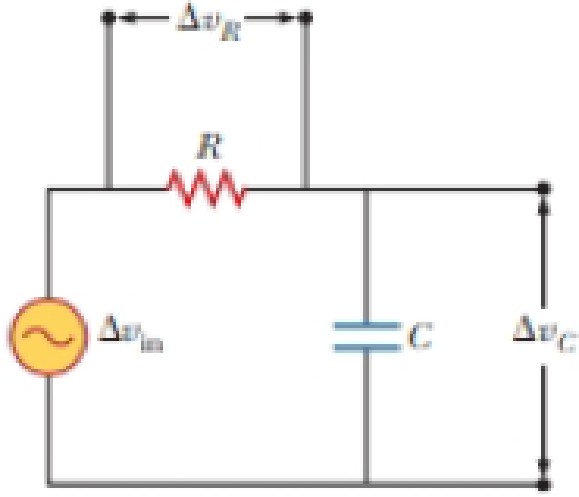
You have decided to build your own speaker system for your home entertainment system. The system will consist of two loudspeakers: a large “woofer,” to which you want to send low audio frequencies (bass), and a small “tweeter,” which should receive high audio frequencies (treble). To separate the high and low frequencies of the audio signal, you build the “crossover network” shown in Figure P32.45. The input voltage is the audio output of the amplifier in your system, shown in the figure as an AC source. You have two outputs as shown: one across the resistor and one across the capacitor. (a) Across which element should you connect the woofer? (b) Across which element should you connect the tweeter? (c) To choose the appropriate values of R and C, you need to determine an expression for the ratio of the output voltage to the input voltage as a function of angular frequency ω for the resistor as an output. (d) You need to determine a similar expression for the ratio of the output voltage to the input voltage as a function of angular frequency ω for the capacitor as an output.
Figure P32.45

Trending nowThis is a popular solution!

Chapter 32 Solutions
Physics for Scientists and Engineers with Modern Physics
- An PLC series circuit with R=600 , L = 30 mH. and c=0.050F is driven by an ac source whose frequency and voltage amplitude are 500 Hz and 50 V, respectively, (a) What is the impedance of the circuit? (b) What is the amplitude of the current in the circuit? (c) What is the phase angle between the emf of the source and the current?arrow_forwardA 30F capacitor is connected across a 60-Hz ac source whose voltage amplitude is 50 V. (a) What is the maximum charge on the capacitor? (b) What is the maximum current into the capacitor? (c) What is the phase relationship between the capacitor charge and the current in the circuit?arrow_forwardAn RLC series circuit has an impedance of 60 and a power factor of 0.50, with the voltage Lagging the current (a) Should a capacitor or an inductor be placed in series with the elements to raise the power factor of the circuit? (b) What is the value of the capacitance or self-inductance that will raise the power factor to unity?arrow_forward
- An LC circuit includes a 0.025-μF capacitor and a 340-μH inductor. Part A If the peak voltage on the capacitor is 190 V, what is the peak current in the inductor? Express your answer in amperes. Ip= .05 X Incorrect; Part B How long after the voltage peak does the current peak occur? Express your answer in microseconds. t = A usarrow_forward1. An inductor and a resistor are connected in series across an AC source as in Figure Q38.1. Immediately after the switch is closed, which of the following state ments is true? a) The current in the circuit is AVR. (b) The voltage across the inductor is zero. (c) The cur rent in the circuit is zero. (d) The voltage across the resistor is AV. (e) The voltage across the inductor is half its maximum value.arrow_forwardAn audio amplifier, represented by the AC source and resistor in Figure P33.7, delivers to the speaker alternating voltage at audio frequencies. If the source voltage has an amplitude of 15.0 V, R= 8.20 ohms and the speaker is equivalent to a resistance of 10.4 ohms, what is the time-averaged power transferred to it?arrow_forward
- An LC circuit with a 5.01 pF capacitor oscillates in such a manner as to radiate at a wavelength of 3.26 m. a) What is the resonant frequency? Hz b) What inductance is in series with the capacitor? µHarrow_forwardH.W 1: The current through a 5-N resistor is given. Find the sinusoidal expression for the voltage across the resistor for i = 40 sin(377t + 30°).arrow_forwardA 12.5-μF capacitor and a 47.5-µF capacitor are connected to an ac generator with a frequency of 60 0 in parallel Hz. What is the capacitive reactance of this pair of capacitors if they are connectedarrow_forward
- A 12.5@mF capacitor and a 47.5@mF capacitor are connected toan ac generator with a frequency of 60.0 Hz. What is the capacitive reactance of this pair of capacitors if they are connected (a) inparallel or (b) in series?arrow_forwardYou have a resistor and a capacitor of unknown values. First, you charge the capacitor and discharge it through the resistor. By monitoring the capacitor voltage on an oscilloscope, you see that the voltage decays to half its initial value in 2.30 ms . You then use the resistor and capacitor to make a low-pass filter. What is the crossover frequency fe? Express your answer with the appropriate units. HA ? Value Unitsarrow_forwardConsider an LC circuit consisting of a 10 microFarady capacitor and a 100 microHenry inductor. At time t = 0, the capacitor has a potential difference of 5 volts between its plates, and zero current is flowing in the circuit. a. What is the oscillation frequency of this circuit in Hz? b. What is the maximum magnitude of the current flowing in this circuit, and at what point in an oscillation cycle does that maximum current flow occur? c. At what point in the cycle is the emf across the inductor zero? Is current flowing through the inductor at this instant? d. At what point in the cycle is the circuit's energy entirely in the form of magnetic field energy? e. How much energy is sloshing around in this circuit? f. At what point in the cycle is the power (rate of energy transfer) to the magnetic field maximum, and what is that maximum power (in watts)?arrow_forward
 Physics for Scientists and Engineers: Foundations...PhysicsISBN:9781133939146Author:Katz, Debora M.Publisher:Cengage Learning
Physics for Scientists and Engineers: Foundations...PhysicsISBN:9781133939146Author:Katz, Debora M.Publisher:Cengage Learning

